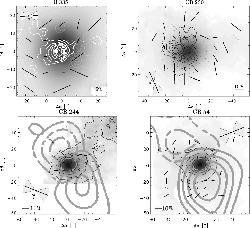



Next: T Tauri Disks
Up: Cores with Protostars
Previous: Cores with Protostars
Contents
Bok globules are isolated dark clouds.
Wolf, Launhardt & Henning (2003) have studied the relation between the
magnetic field and outflow directions.
Figure 1.21 displays the direction of
the magnetic field obtained with JCMT-SCUBA polarization observation
in 850 m as well as the outflow found by
m as well as the outflow found by  CO observation
of Chandler & Sargent (1993) and
CO observation
of Chandler & Sargent (1993) and  CO observation by
Yun & Clemens (1994).
In B 335, CB 230 and CB 244
outflows are oriented in the direction perpendicular to the major axis of the
globules.
The magnetic field is running parallel to the outflow but perpendicular to the
major axis.
This means that a disk is formed with a gas flowing along the magnetic field.
Further, the outflow is generated by a twisted magnetic field which
is an outcome of a rotating disk.
In globule CB 54, the alignment is not perfect, that is,
magnetic field direction is slightly aligned with the outflow
(Wolf, Launhardt & Henning 2003).
This seems to stengthen the magnetic origin of the outflow and
magnetically guided disk formation.
It is clearly shown that the polarization anti-correlates with
the intensity of the thermal emission.
This might be due to the observational error in the low intensity region
(or low S/N region).
This may be related to physical processes such as
(1) the alingnment owing to the magnetic field becomes inefficient
in high density region or
(2) the magnetic field is tangled in the dense region and the polarization
due to the aligned dust is canceled.
CO observation by
Yun & Clemens (1994).
In B 335, CB 230 and CB 244
outflows are oriented in the direction perpendicular to the major axis of the
globules.
The magnetic field is running parallel to the outflow but perpendicular to the
major axis.
This means that a disk is formed with a gas flowing along the magnetic field.
Further, the outflow is generated by a twisted magnetic field which
is an outcome of a rotating disk.
In globule CB 54, the alignment is not perfect, that is,
magnetic field direction is slightly aligned with the outflow
(Wolf, Launhardt & Henning 2003).
This seems to stengthen the magnetic origin of the outflow and
magnetically guided disk formation.
It is clearly shown that the polarization anti-correlates with
the intensity of the thermal emission.
This might be due to the observational error in the low intensity region
(or low S/N region).
This may be related to physical processes such as
(1) the alingnment owing to the magnetic field becomes inefficient
in high density region or
(2) the magnetic field is tangled in the dense region and the polarization
due to the aligned dust is canceled.
Figure 1.21:
Directions of magnetic field are shown from the linear polarization observation of 850
 m thermal emission from dusts by JCMT-SCUBA.
These four objects are known as Bok globules.
The bars with
m thermal emission from dusts by JCMT-SCUBA.
These four objects are known as Bok globules.
The bars with  represent the average directions of
polarization (E-vector), which are perpendicular to the magnetic field.
represent the average directions of
polarization (E-vector), which are perpendicular to the magnetic field.
 |




Next: T Tauri Disks
Up: Cores with Protostars
Previous: Cores with Protostars
Contents
Kohji Tomisaka
2007-11-02

